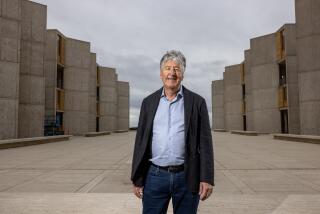Scientists Honored With Prestigious Memberships
- Share via
Three San Diego scientists have been elected to membership in the prestigious National Academy of Sciences or its Institute of Medicine.
Dr. Richard Lerner, director of the Research Institute of Scripps Clinic, was elected to membership in the National Academy of Sciences.
Elected to the Institute of Medicine were Dr. Elizabeth Barrett-Connor, professor and chairwoman of the department of community and family medicine at UC San Diego, and Yuan-Cheng B. Fung, emeritus professor of bioengineering at UCSD.
The National Academy of Sciences, which was chartered by Congress in 1863, is independent of the federal government but serves as its official adviser on scientific matters. Membership, which now numbers 1,626, is considered the highest honor that can be accorded a scientist or engineer.
“I’m very pleased,” Lerner said Monday of his selection. The voting “is very confidential, so you just never know.”
Lerner has been director of Scripps Research Institute since 1987. His research concentrates on making antibodies that speed up chemical reactions. Because the antibodies function as enzymes, Lerner and colleagues named them “abzymes.”
Recently, the institute has expanded by recruiting both promising young faculty and established researchers. It receives more research dollars from the National Institutes of Health than any other private, nonprofit biomedical research facility.
Barrett-Connor is widely regarded as a leading researcher in the role of estrogen in protecting women from heart disease. She also has conducted long-term studies of health as people age.
Fung focuses on rheology, the science of the flow and change of bodily fluids as well as of the mechanics of soft tissues such as the heart. He is involved in the complex task of describing the entire system of blood circulation in the heart and its associated vessels.
Among the questions he wants to answer is how changes in blood pressure might deform and destroy the lining of blood vessels.
Scientists hope that, together with emerging evidence about the molecular bases of heart diseases, such a biomechanical approach will point to new treatments.
Neither Barrett-Connor nor Fung could be reached for comment.
The National Academy of Sciences created the Institute of Medicine in 1970 to recognize researchers who have made major contributions specifically to health, medicine or related fields. Membership stands at 471.
New members of both organizations were elected last week by current active members at their annual mass meeting.
San Diego’s research community is so large that dozens of people here are members of the academy or the institute.
UCSD has 51 members of the National Academy of Sciences. Salk Institute has six members, and Scripps Clinic and Research Foundation has five, including its past director, Dr. Frank Dixon.






